-
ORIGINAL ARTICLE10-01-2022
Mental health assistance: identification of nursing diagnoses in a community mental health service
Revista Brasileira de Enfermagem. 2022;75(2):e20201175
Abstract
ORIGINAL ARTICLEMental health assistance: identification of nursing diagnoses in a community mental health service
Revista Brasileira de Enfermagem. 2022;75(2):e20201175
DOI 10.1590/0034-7167-2020-1175
Views0See moreABSTRACT
Objective:
to map and identify nursing diagnoses targeted at night care users in a Psychosocial Care Center according to NANDA-I Taxonomy.
Method:
this is a descriptive-exploratory study, of documentary research type of 319 records in medical records. It was held in a Psychosocial Care Center III in Goiás, from 2014-2018. Nursing diagnoses and records were extracted with non-standardized language.
Results:
813 records of nursing diagnoses identified in 53 different titles, in 10 domains, were identified. The most frequent diagnosis was risk for self-extermination. The domain with the highest number of diagnostic records was activity/rest. There was a predominance of diagnoses focused on the problem.
Final considerations:
mapping contributes to the planning of evidence-based nursing interventions and to the strengthening of professional identity in mental health. It is evident the need for practices that go beyond the symptoms in a preventive perspective, with a view to comprehensiveness.
-
ORIGINAL ARTICLE10-01-2022
Training-professional profile of nurses teaching at the Technical Schools of the Unified Health System
Revista Brasileira de Enfermagem. 2022;75(2):e20201142
Abstract
ORIGINAL ARTICLETraining-professional profile of nurses teaching at the Technical Schools of the Unified Health System
Revista Brasileira de Enfermagem. 2022;75(2):e20201142
DOI 10.1590/0034-7167-2020-1142
Views0See moreABSTRACT
Objective:
to describe the training-professional profile of nursing professors in the vocational course in nursing at the Technical Schools of the Unified Health System.
Methods:
a quantitative descriptive research, carried out with 61 nurses who are professors of technical courses in nursing at five technical schools in three Brazilian regions. Data were collected through an online questionnaire and submitted to descriptive analysis.
Results:
only 36% of teaching nurses were licensed and 80% had a specialization in nursing or health. Although 95.1% of participants considered training for teaching necessary, 44.2% did not have qualifications for this job. The average length of work in care was 8 years, focusing on the hospital network.
Conclusion:
the need for professor training and investment in it is evidenced, as the training of essential workers for nursing care and consolidation of the Unified Health System is on the agenda.
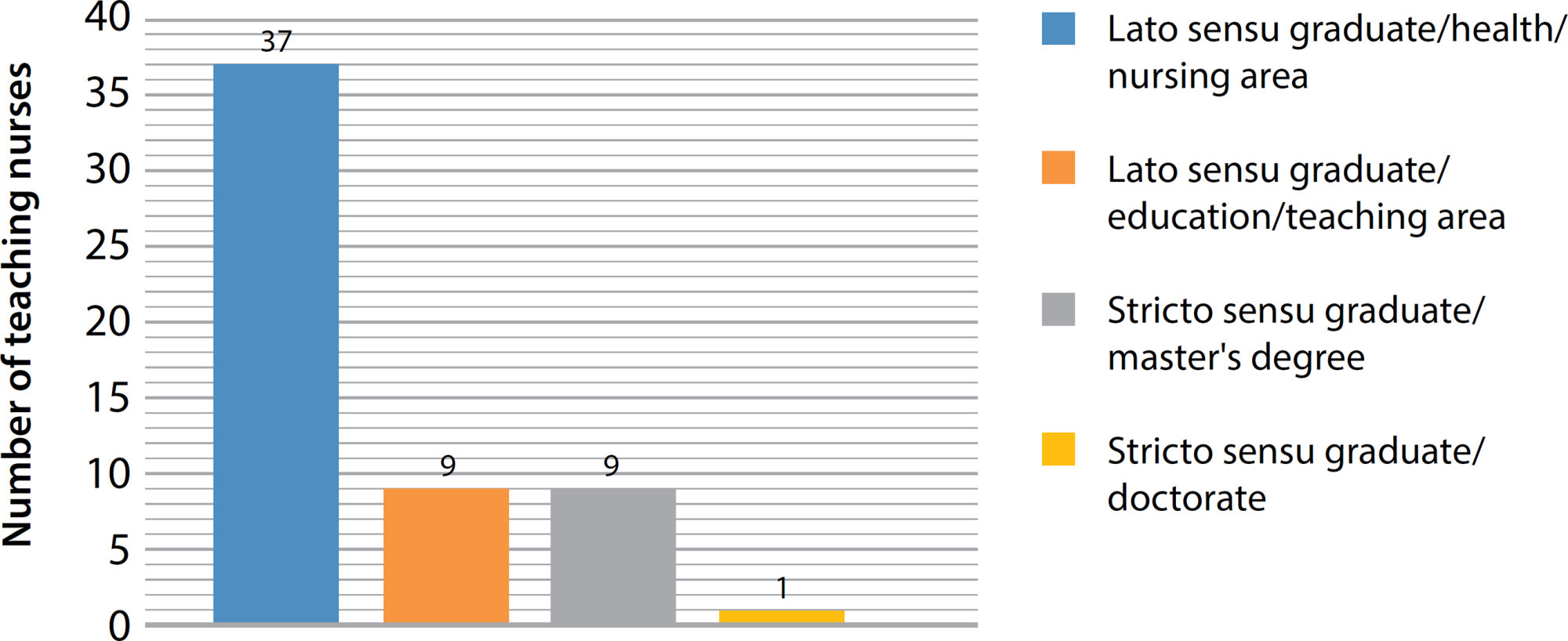
-
ORIGINAL ARTICLE10-01-2022
Continuing health education for qualification of professional practice in Psychosocial Care Centers
Revista Brasileira de Enfermagem. 2022;75(2):e20210155
Abstract
ORIGINAL ARTICLEContinuing health education for qualification of professional practice in Psychosocial Care Centers
Revista Brasileira de Enfermagem. 2022;75(2):e20210155
DOI 10.1590/0034-7167-2021-0155
Views0See moreABSTRACT
Objective:
to describe and analyze a strategy of continuing health education to manage the quality of professionals’ work in Psychosocial Care Centers.
Method:
this is a research-intervention carried out in Psychosocial Care Centers in the state of Goiás, Brazil, with the participation of 58 professionals. Data were collected in 2016 through seminars and workshops. Thematic content analysis was carried out.
Results:
professionals associated the Singular Therapeutic Project to the record of performed procedures and described the need to develop skills for correct completion and interpretation of procedures, use of a record software and computerization of processes. The qualification strategy used was considered to be effective in making improvements to the work carried out feasible.
Final Considerations:
the study presents a qualification strategy for community mental health service teams to guide the care model for territorial care centered on users.

-
ORIGINAL ARTICLE10-01-2022
Frailty in the elderly: screening possibilities in Primary Health Care
Revista Brasileira de Enfermagem. 2022;75(2):e20200973
Abstract
ORIGINAL ARTICLEFrailty in the elderly: screening possibilities in Primary Health Care
Revista Brasileira de Enfermagem. 2022;75(2):e20200973
DOI 10.1590/0034-7167-2020-0973
Views0See moreABSTRACT
Objectives:
to evaluate two instruments for screening frailty in the elderly in Primary Health Care.
Methods:
this is an observational, cross-sectional study, with a quantitative approach, with 396 elderly people. SPSS software helped to perform the statistical analyses. The study used the kappa coefficient and Spearman’s correlation.
Results:
the kappa coefficient between the Clinical-Functional Vulnerability Index 20 and the Edmonton Frailty Scale was 0.496, considered moderate. There was a positive and significant correlation (r = 0.77; p < 0.001) between the frailty conditions and the total score of the two instruments.
Conclusions:
when this article assessed fragility through the kappa coefficient, both instruments presented positive correlation and agreement. However, the identification of frailty was higher when it used the Edmonton Frailty Scale.
-
ORIGINAL ARTICLE10-01-2022
Factors associated with vulnerability and fragility in the elderly: a cross-sectional study
Revista Brasileira de Enfermagem. 2022;75(2):e20200399
Abstract
ORIGINAL ARTICLEFactors associated with vulnerability and fragility in the elderly: a cross-sectional study
Revista Brasileira de Enfermagem. 2022;75(2):e20200399
DOI 10.1590/0034-7167-2020-0399
Views0See moreABSTRACT
Objectives:
to assess factors associated with vulnerability and fragility in the elderly.
Methods:
crosssectional study with 384 elderly people in Fortaleza, Ceará. The Vulnerable Elders Survey and Clinical-Functional Vulnerability Index – 20 were used. Chi-square and Fisher’s exact tests were used for associations. In the analysis of the combined influence of risk factors, the stepwise logistic regression and multinomial regression methods were adopted.
Results:
251 (65.4%) non-vulnerable and 133 (34.6%) vulnerable elders. From the vulnerable elders analyzed, 42 (30.9%) are at high risk for frailty. Factors associated with vulnerability: age, gender, presence of comorbidities, hypertension, diabetes, osteoporosis and use of polypharmacy. There is a 30% increase in the chance of vulnerability for each additional drug. Physical activity reduces the chance of vulnerability by 60%. Factors associated with frailty: educational level; self-perception of health; comorbidities; polypharmacy.
Conclusions:
it is important to pay attention to the presence of arterial hypertension, osteoporosis, polypharmacy, and encourage the practice of physical activity.
-
10-01-2022
Sintomas musculoesqueléticos em cuidadores formais e informais de idosos
Revista Brasileira de Enfermagem. 2022;75(2):e20210249
Abstract
Sintomas musculoesqueléticos em cuidadores formais e informais de idosos
Revista Brasileira de Enfermagem. 2022;75(2):e20210249
DOI 10.1590/0034-7167-2021-0249
Views0See moreRESUMEN
Objetivo:
Evaluar los síntomas musculoesqueléticos en cuidadores formales e informales de los ancianos y verificar la asociación con factores personales y laborales. Métodos: Estudio transversal. Los instrumentos para la evaluación fueron el Cuestionario Internacional de Actividad Física (IPAQ), Self-Reporting Questionnaire-20, Escala de Percepción del Esfuerzo de Borg y el Cuestionario Nórdico de Síntomas Musculoesqueléticos.
Resultados:
Los cuidadores informales trabajaron más tiempo (60,2% vs. 41%), tuvieron más horas de trabajo (37,4% >12h por día), menos tiempo libre (85,4% vs. 2,5%) y falta de pautas de atención (90,2%). La región con más síntomas musculoesqueléticos fue la columna vertebral y, cuanto mayor la dependencia de los ancianos, mayores son las posibilidades de desarrollar síntomas musculoesqueléticos (OR= 1.3, 95% CI= 1.1-1.6, p <0.05).
Conclusión:
Factores personales y relacionados con el trabajo fueron más frecuentes en los cuidadores informales y la dependencia de los ancianos interfiere con el aumento de los síntomas musculoesqueléticos en cuidadores.
-
ORIGINAL ARTICLE10-01-2022
ICNP® terminology subset for the care of people with heart failure
Revista Brasileira de Enfermagem. 2022;75(2):e20210196
Abstract
ORIGINAL ARTICLEICNP® terminology subset for the care of people with heart failure
Revista Brasileira de Enfermagem. 2022;75(2):e20210196
DOI 10.1590/0034-7167-2021-0196
Views0See moreABSTRACT
Objective:
to develop an ICNP® terminology subset for the care of people with heart failure.
Methods:
this is a methodological study, which used the theoretical framework of the Mid-Range Nursing Theory for Cardiovascular Rehabilitation, with the steps: Construction of nursing diagnoses/outcomes and interventions statements and Cross-mapping of statements constructed.
Results:
forty-two diagnosis/outcome statements and 179 nursing intervention statements were constructed, organized based on five theory concepts, with a higher prevalence of statements related to “Rehabilitative care”, “Psychosocial support for patients and families” and “Supervised cardiovascular rehabilitation program”.
Final considerations:
it was possible to build nursing diagnosis/outcome and intervention statements for developing a terminology subset for the care of people with heart failure, based on the chosen theory.
-
10-01-2022
Kangaroo Method: potentialities, barriers and difficulties in humanized care for newborns in the Neonatal ICU
Revista Brasileira de Enfermagem. 2022;75(2):e20201121
Abstract
Kangaroo Method: potentialities, barriers and difficulties in humanized care for newborns in the Neonatal ICU
Revista Brasileira de Enfermagem. 2022;75(2):e20201121
DOI 10.1590/0034-7167-2020-1121
Views0See moreABSTRACT
Objective:
To identify the potentialities, barriers and difficulties for the implementation of humanized care from the perspective of the Kangaroo Method.
Methods:
Integrative literature review with a time cut from 02/01/2015 to 06/01/2019, totaling ten articles in the final sample.
Results:
The findings were categorized into two categories: Potentialities for humanized care from the perspective of the Kangaroo Method; Barriers or difficulties to the implementation of the Kangaroo Method. Several potentialities for humanized care allied to technology and continuing education were identified, as well as several barriers to the implementation of the Kangaroo Method, such as lack of physical space, lack of professionals and team training, lack of knowledge, lack of adherence and professional demotivation.
Final considerations:
There are still few studies that address the potentialities, barriers and difficulties for the implementation of humanized care from the perspective of the Kangaroo Method, and most of those included in this review were conducted in Brazil and present a qualitative approach.

-
REVIEW06-01-2020
Access of the black population to health services: integrative review
Revista Brasileira de Enfermagem. 2020;73(4):e20180834
Abstract
REVIEWAccess of the black population to health services: integrative review
Revista Brasileira de Enfermagem. 2020;73(4):e20180834
DOI 10.1590/0034-7167-2018-0834
Views1See moreABSTRACT
Objectives:
demonstrate and discuss how the black population’s access to health services occurs
Methods:
integrative literature review with the following question: How does the black population’s access to health services occur? The search was carried out in the Scholar, LILACS and SciELO databases and used the descriptor “access to health services” and the term “population,” resulting in a sample with twelve articles.
Results:
studies show that the difficulty of access is a fundamental factor for the quality of life of people, directly compromising preventive services, especially for women’s health and, in addition, it has significant impact on the illness process of the black population within its particularities.
Final Considerations:
several limiting factors compromise the black population’s access to health services, including institutional and structural factors

-
REVIEW11-06-2020
Transitional care to caregivers of dependent older people: an integrative literature review
Revista Brasileira de Enfermagem. 2020;73:e20200394
Abstract
REVIEWTransitional care to caregivers of dependent older people: an integrative literature review
Revista Brasileira de Enfermagem. 2020;73:e20200394
DOI 10.1590/0034-7167-2020-0394
Views1See moreABSTRACT
Objective:
To identify the needs of caregivers of dependent older people related to self-care in the transition from hospital to home.
Methods:
Integrative literature review that followed a predefined protocol, carried out from March to May 2019 in the platforms EBSCO, B-On, Scopus, Web of Science, and Joanna Briggs Institute. Descriptors and eligibility criteria were defined for the bibliographic sample, which was ten articles. The search was limited to articles published between 2015 and 2019 to guarantee evidence topicality.
Results:
The needs of caregivers related to transitional care can be grouped into five categories: needs in the transition into the role of caregiver; needs related to self-care of caregivers themselves; health needs; economic needs; and social and collective needs.
Final considerations:
The work developed by nurses regarding transitional care of caregivers must have two focuses: managing care provided to dependent older people and managing the needs of caregivers and the care offered to them.
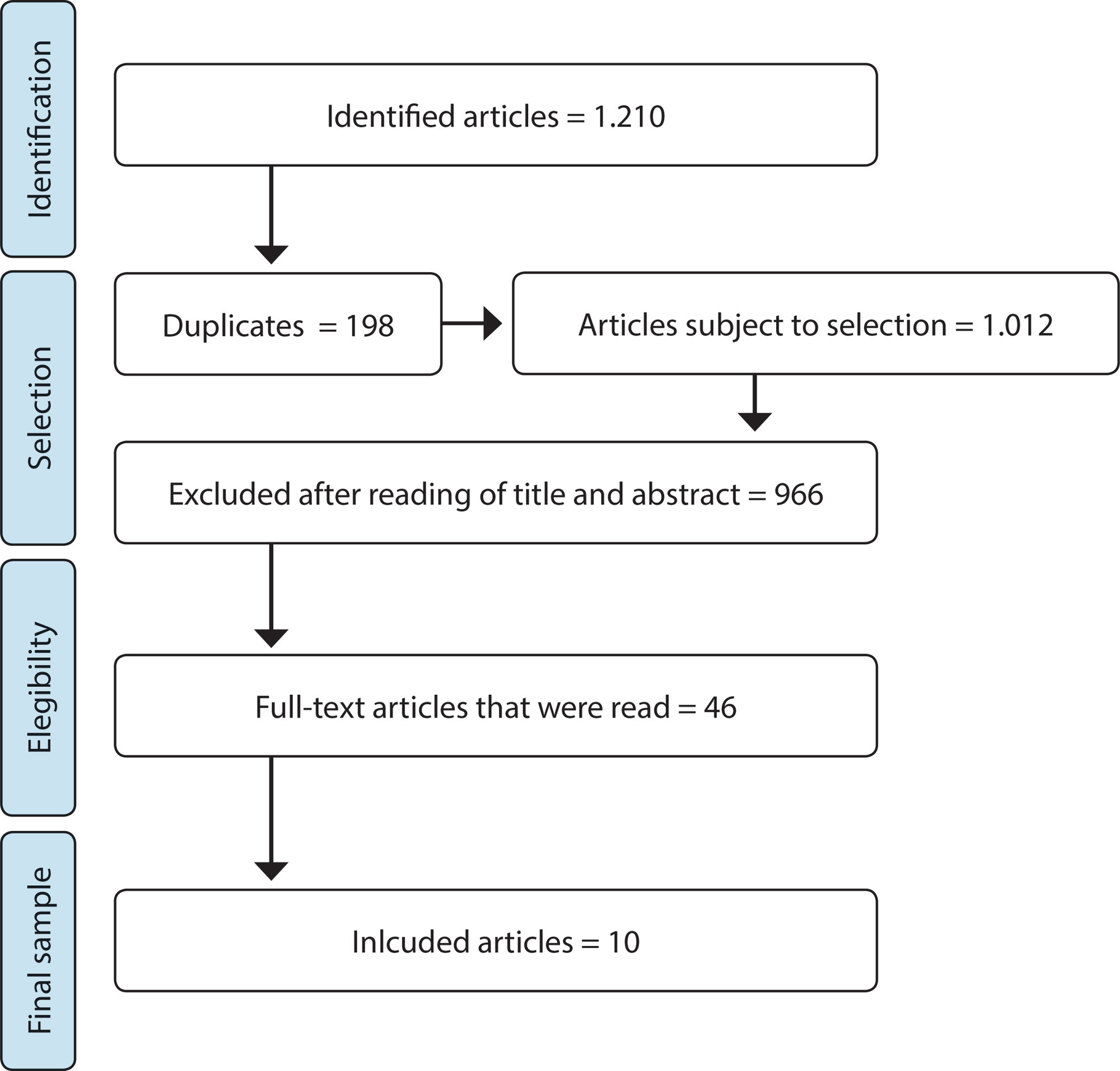
-
REVIEW10-19-2020
Validation methods of nursing protocols: an integrative review
Revista Brasileira de Enfermagem. 2020;73:e20200050
Abstract
REVIEWValidation methods of nursing protocols: an integrative review
Revista Brasileira de Enfermagem. 2020;73:e20200050
DOI 10.1590/0034-7167-2020-0050
Views0See moreABSTRACT
Objective:
to identify scientific production about validation methods of nursing care protocols.
Method:
an integrative review with search at Scielo, Pubmed/MEDLINE, Virtual Health Library, Web of Science, Scopus, and EBSCOhost. The descriptors “validation studies”, “validation studies as topic”, “protocols”, “clinical protocols”, “practice guidelines as topic”, “nursing” and “nursing assessment” and the uncontrolled descriptor “validation” were used.
Results:
thirty-two articles were selected, most of them Brazilian. Content validation by experts was the most frequent method, with no consensus on the number of participants for the process. The collection instruments were mostly created by the authors. Data analysis was performed using descriptive statistics and Content Validity Index, with a variable consensus rate in the analyzed articles.
Conclusion:
protocols validated by experts are robust tools for use in clinical practice, with methodological rigor in development essential for its quality.
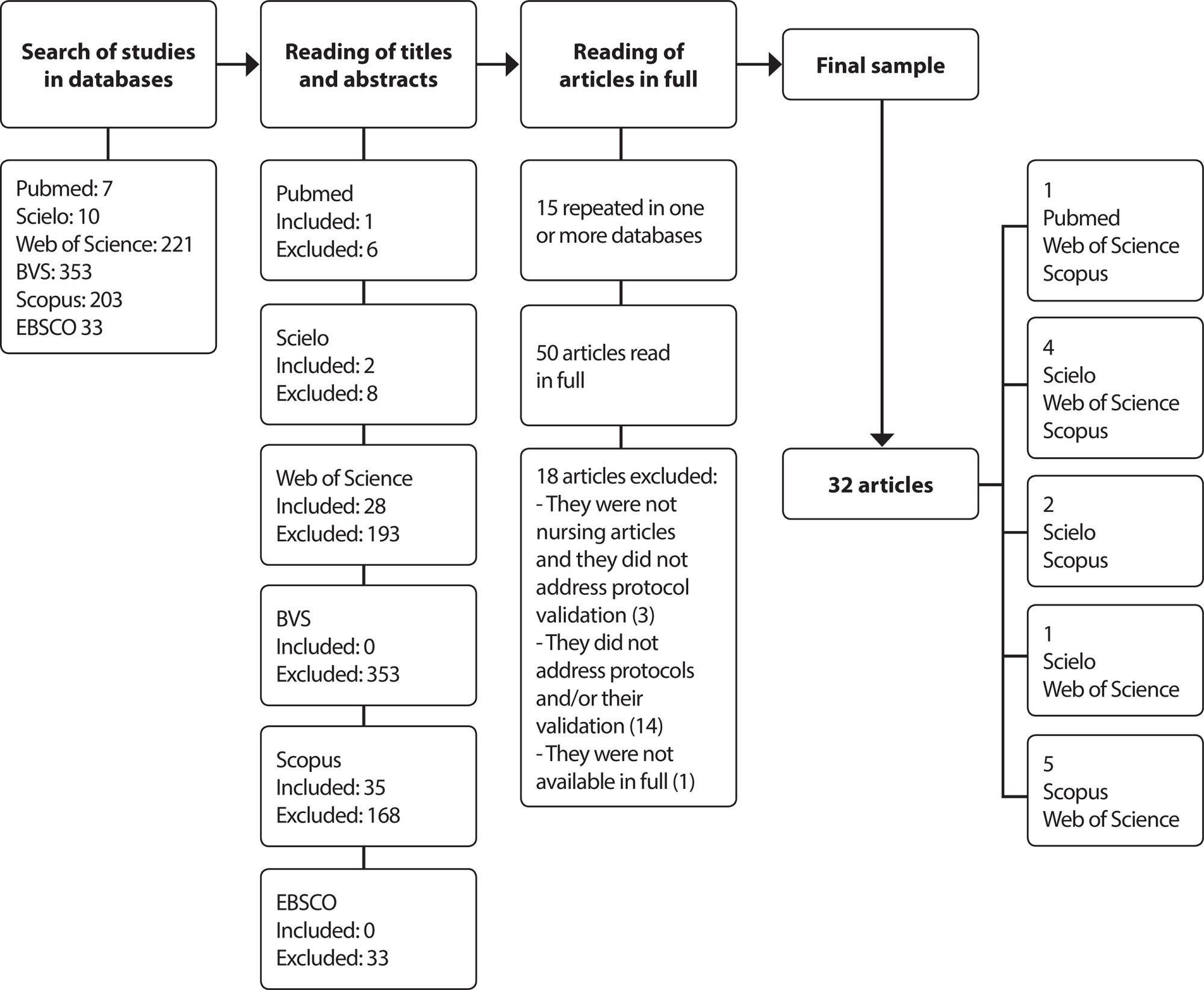
-
ORIGINAL ARTICLE05-24-2021
PEDCARE: validation of a mobile application on diabetic foot self-care
Revista Brasileira de Enfermagem. 2021;74:e20200856
Abstract
ORIGINAL ARTICLEPEDCARE: validation of a mobile application on diabetic foot self-care
Revista Brasileira de Enfermagem. 2021;74:e20200856
DOI 10.1590/0034-7167-2020-0856
Views0See moreABSTRACT
Objective:
to describe the process of validating a multimedia application on a mobile platform to promote foot care for people with diabetes.
Method:
a technological production and methodological type study. Content and appearance were validated by 39 judges (29 nursing judges and ten information and communication technology judges and 15 people from the target audience).
Results:
nursing judges made it possible to validate the material with a total Content Validity Index of 0.95, a non-significant binomial test for most items and Cronbach’s alpha of 0.92, information and communication technology judges with Suitability Assessment of Materials of 99.2% and the target audience with an agreement index of 98%.
Conclusion:
the application proved to be valid and reliable for use in clinical practice as an educational technology to promote foot care for people with diabetes.
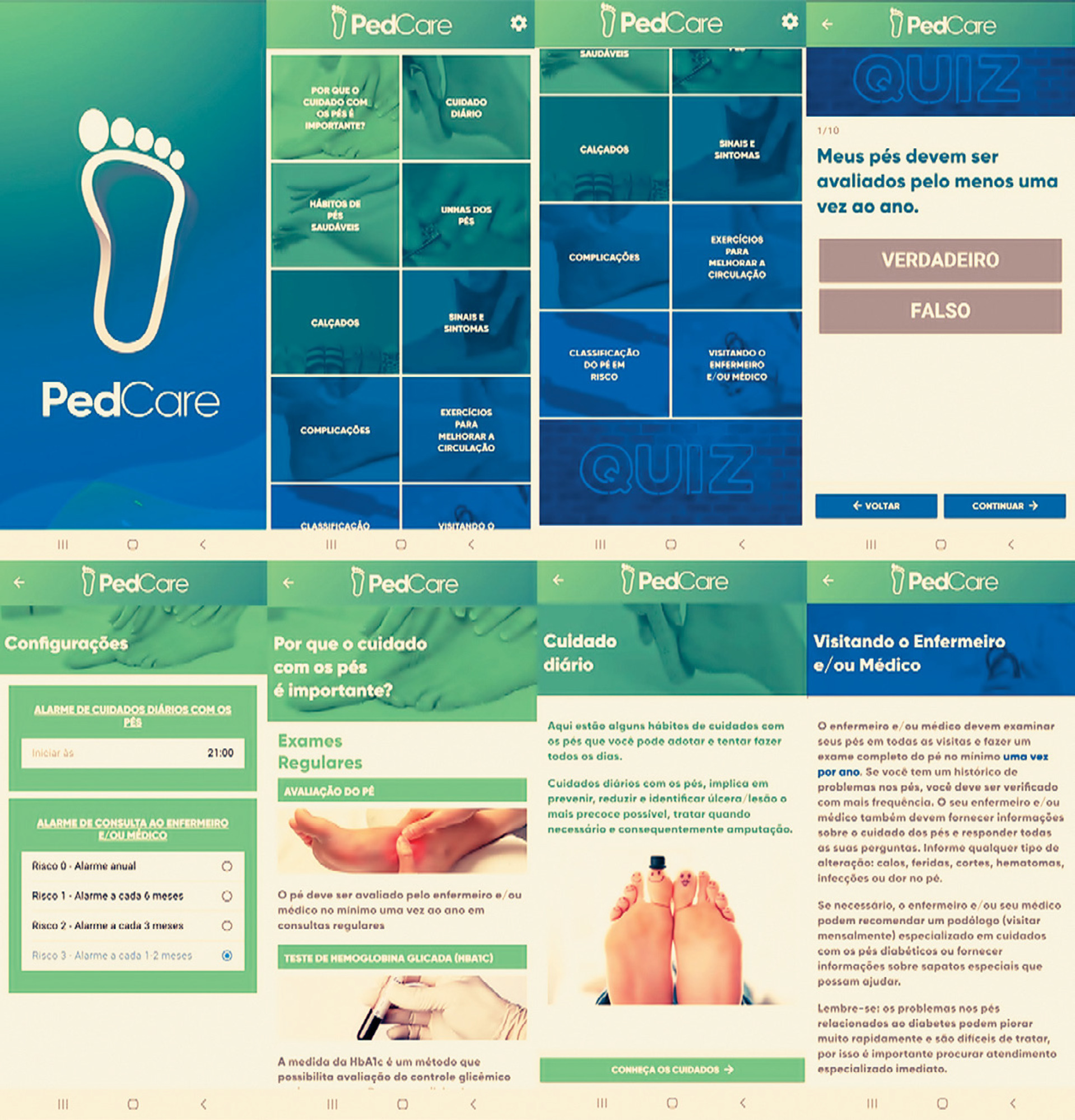
-
EXPERIENCE REPORT04-09-2020
Implementation of an Artificial Intelligence Algorithm for sepsis detection
Revista Brasileira de Enfermagem. 2020;73(3):e20180421
Abstract
EXPERIENCE REPORTImplementation of an Artificial Intelligence Algorithm for sepsis detection
Revista Brasileira de Enfermagem. 2020;73(3):e20180421
DOI 10.1590/0034-7167-2018-0421
Views0See moreABSTRACT
Objectives:
to present the nurses’ experience with technological tools to support the early identification of sepsis.
Methods:
experience report before and after the implementation of artificial intelligence algorithms in the clinical practice of a philanthropic hospital, in the first half of 2018.
Results:
describe the motivation for the creation and use of the algorithm; the role of the nurse in the development and implementation of this technology and its effects on the nursing work process.
Final Considerations:
technological innovations need to contribute to the improvement of professional practices in health. Thus, nurses must recognize their role in all stages of this process, in order to guarantee safe, effective and patient-centered care. In the case presented, the participation of the nurses in the technology incorporation process enables a rapid decision-making in the early identification of sepsis.
-
REVIEW03-24-2021
Development of clinical competence in nursing in simulation: the perspective of Bloom’s taxonomy
Revista Brasileira de Enfermagem. 2021;74(1):e20200135
Abstract
REVIEWDevelopment of clinical competence in nursing in simulation: the perspective of Bloom’s taxonomy
Revista Brasileira de Enfermagem. 2021;74(1):e20200135
DOI 10.1590/0034-7167-2020-0135
Views0See moreABSTRACT
Objectives:
to investigate the scientific evidence on the use of Bloom’s taxonomy for developing competence in nursing professionals and students in clinical simulation.
Methods:
integrative review of the National Library of Medicine (NLM), National Institutes of Health (NIH), Cumulative Index to Nursing and Allied Health Literature (CINAHL), Latin American and Caribbean Literature in Health Sciences (LILACS), Web of Science and SCOPUS databases, using the Rayyan application.
Results:
a total of 871 studies were identified; four composed the sample. The development of clinical competence occurred through the coordination of knowledge, skills, and attitudes. To develop the cognitive domain, the objectives of knowledge and comprehension of the Bloom’s taxonomy were mobilized. The psychomotor domain required development of the skills demanded by the proposed clinical care. The affective domain was developed through will and motivation to learn.
Conclusions:
it is possible to develop clinical competence in nursing by adopting Bloom’s taxonomy in each phase of clinical simulation.
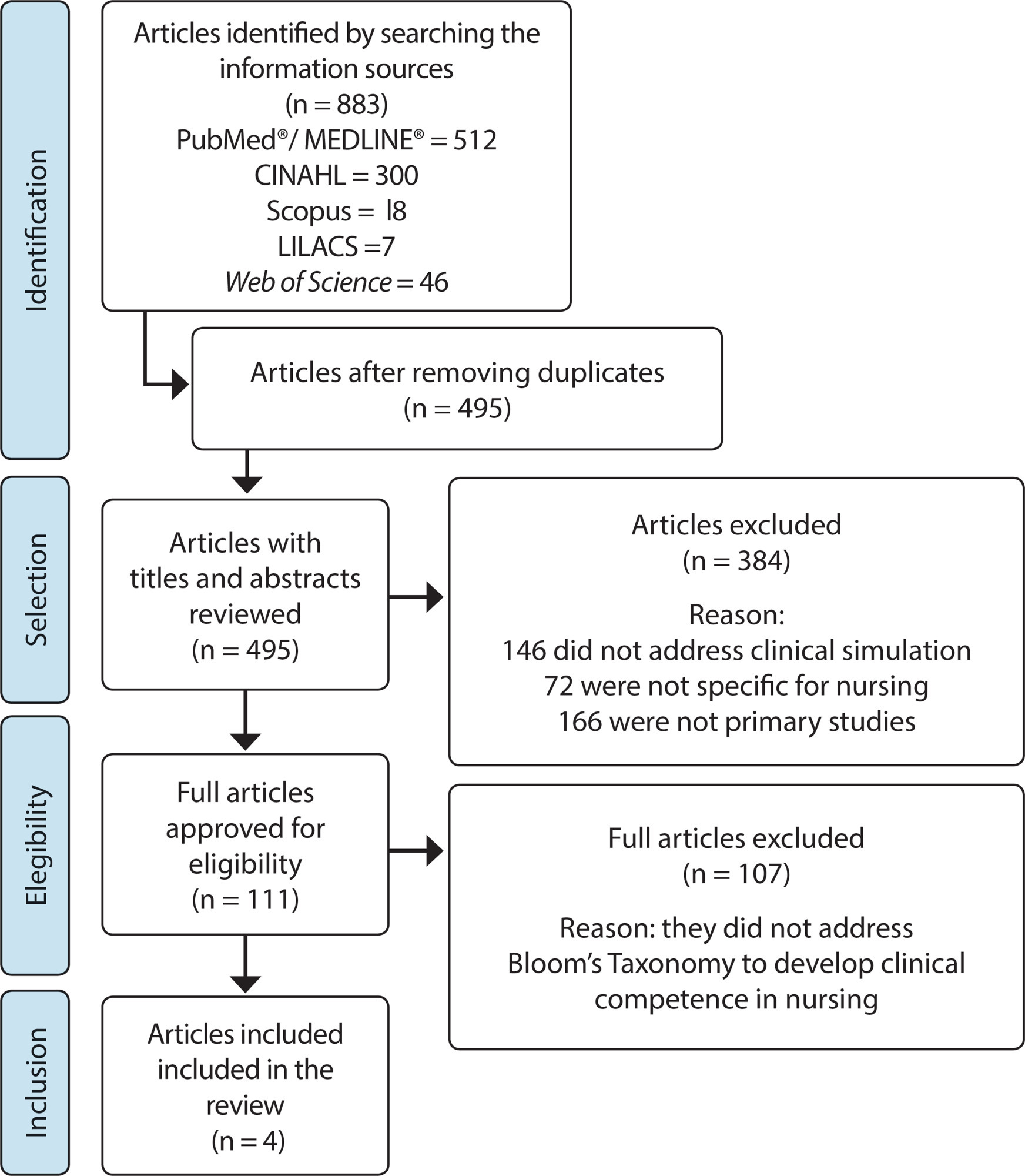
-
03-27-2020
Coronavirus 2020
Revista Brasileira de Enfermagem. 2020;73(2):e2020n2
Abstract
Coronavirus 2020
Revista Brasileira de Enfermagem. 2020;73(2):e2020n2
DOI 10.1590/0034-7167-2020730201
Views0Emerging and reemerging infectious diseases are constant challenges for public health worldwide. Recent cases of pneumonia of unknown cause in Wuhan, China, have led to the discovery of a new type of Coronavirus (2019-nCoV), which are enveloped RNA viruses, commonly found in humans, other mammals and birds, capable of causing respiratory, enteric, hepatic, and neurological […]See more -
ORIGINAL ARTICLE12-13-2019
Accessibility of children with special health needs to the health care network
Revista Brasileira de Enfermagem. 2019;72:65-71
Abstract
ORIGINAL ARTICLEAccessibility of children with special health needs to the health care network
Revista Brasileira de Enfermagem. 2019;72:65-71
DOI 10.1590/0034-7167-2017-0899
Views0See moreABSTRACT
Objective:
To know how children with special health needs access the health care network.
Method:
This is a qualitative research of descriptive-exploratory type, developed using semi-structured interviews mediated by the Talking Map design. Participants were 19 family caregivers of these children in two Brazilian municipalities. Data were submitted to inductive thematic analysis.
Results:
Difficulties were mentioned from the diagnosis moment to the specialized follow-up, something represented by the itinerary of the c hild and his/her family in the search for the definition of the medical diagnosis and the access to a specialized professional; a gap between the children’s needs and the care offered was observed in primary health care.
Conclusion:
The access of children with special health needs is filled with obstacles such as slowness in the process of defining the child’s diagnosis and referral to a specialist. Primary health care services were replaced by care in emergency care units.
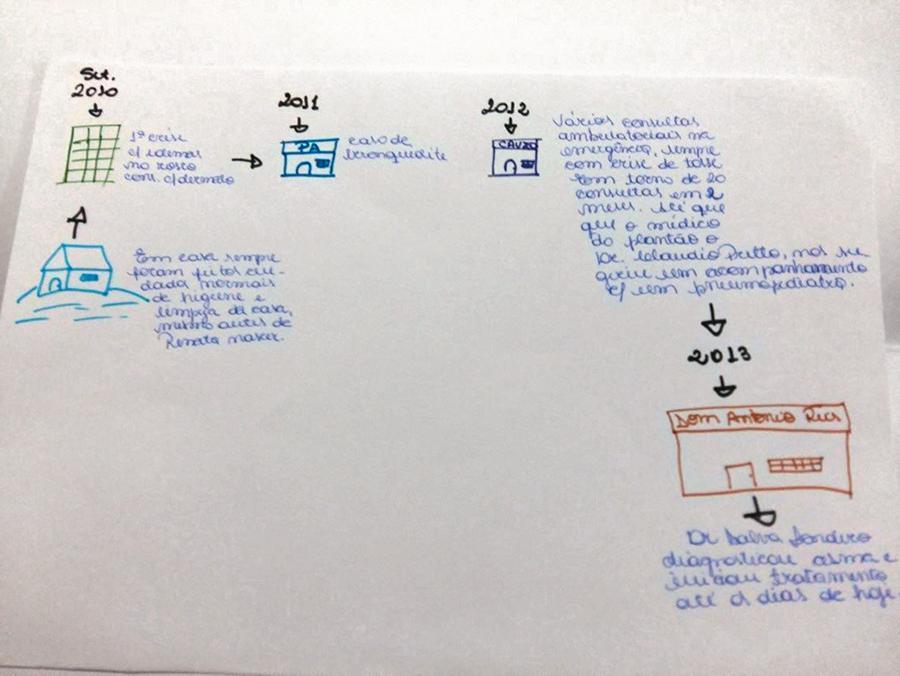
Search
Search in:
Nuvem de Tags
Adolescente (85) Atenção Primária à Saúde (239) COVID-19 (91) Criança (91) Cuidados de Enfermagem (269) Educação em Enfermagem (151) Educação em Saúde (139) Enfermagem (930) Enfermagem Pediátrica (86) Estudantes de Enfermagem (77) Estudos de Validação (131) Família (87) Idoso (208) Promoção da Saúde (99) Qualidade de Vida (104) Saúde do Trabalhador (86) Saúde Mental (145) Saúde Pública (82) Segurança do Paciente (150) Tecnologia Educacional (100)



